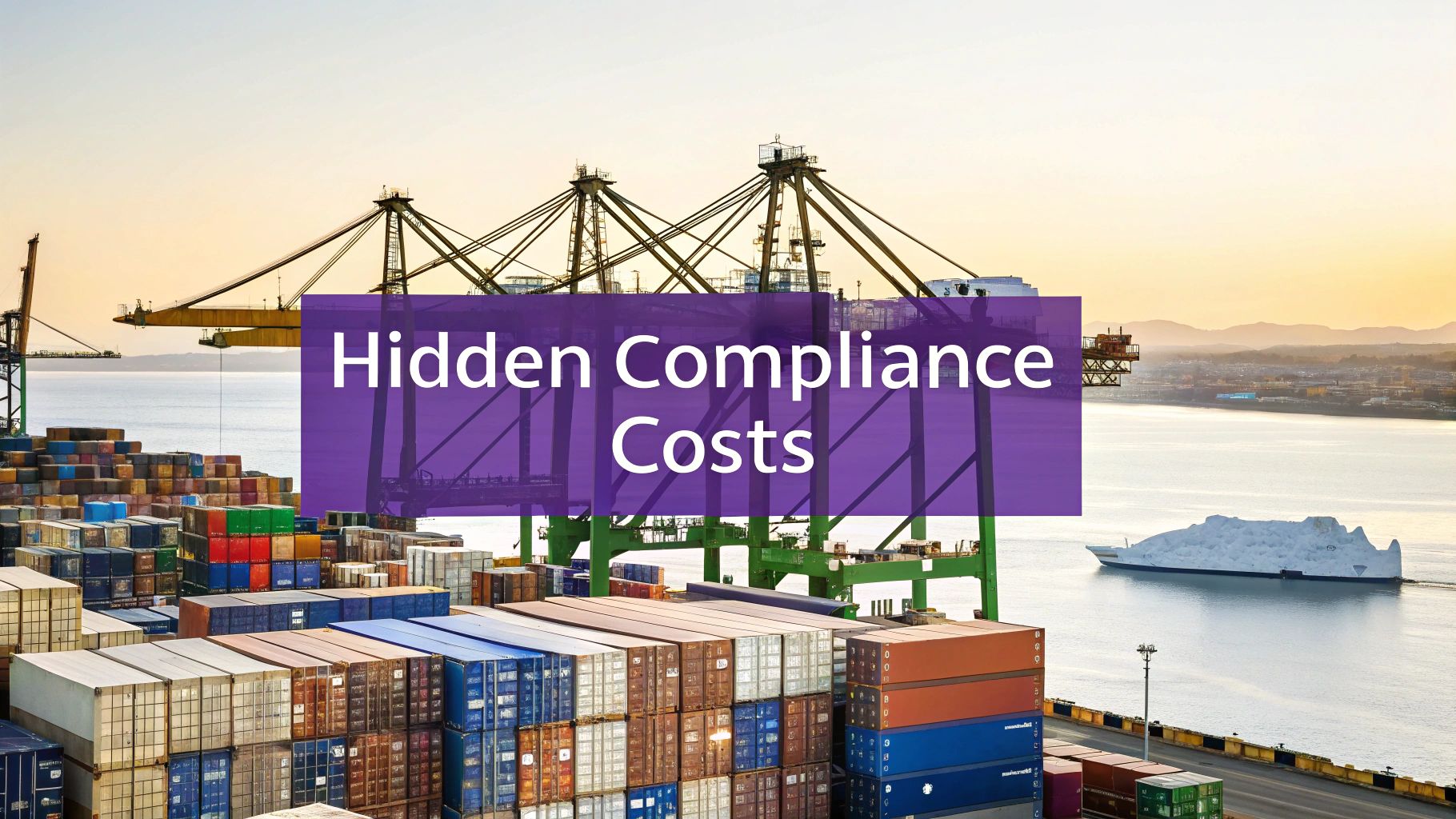
The True Cost of Shipping Compliance Violations: Fines Fees and Consequences
Discover the true cost of shipping compliance violations, including fines, hidden fees, and legal risks. Protect your business now!
Cody Y.
Updated on Sep 30, 2025
When a business gets hit with a shipping compliance violation, the government-issued fine is just the beginning of the nightmare. It’s the obvious part, the tip of the iceberg everyone sees.
But what most people don’t realize is that lurking just beneath the surface is a massive, unseen collection of costs that can truly sink a company. The real cost of a violation is a painful ripple effect of hidden expenses, operational shutdowns, and legal battles that can threaten a business’s very future.
Beyond the Fine: The Hidden Costs of a Violation
The moment a shipment gets flagged for non-compliance, the dominoes start to fall. Operations can grind to a halt as regulators seize your goods, leading to indefinite delays at the port and a flood of angry customer emails.
This single disruption triggers a cascade of secondary costs that many businesses are completely unprepared for. The initial penalty quickly becomes a footnote in a much larger financial crisis.
The Unseen Financial Drain
The financial bleeding doesn’t stop with the fine. A whole new set of unexpected operational costs starts to pile up, turning one mistake into a prolonged headache.
These often include:
- Emergency Legal Fees: Suddenly, you need a trade attorney to navigate the appeals process. This can easily run into the tens of thousands of dollars.
- Storage and Demurrage Charges: While your goods are impounded, they're racking up daily storage fees at the port or warehouse. These charges escalate fast.
- Increased Insurance Premiums: A compliance violation brands you as a high-risk business. The result? Substantially higher insurance costs for years to come.
- Lost Revenue: Delayed or canceled orders hit the bottom line immediately. Worse, the hit to your reputation can scare off future customers, causing long-term damage.
This is a problem that branches out, creating a tangled web of expensive consequences.
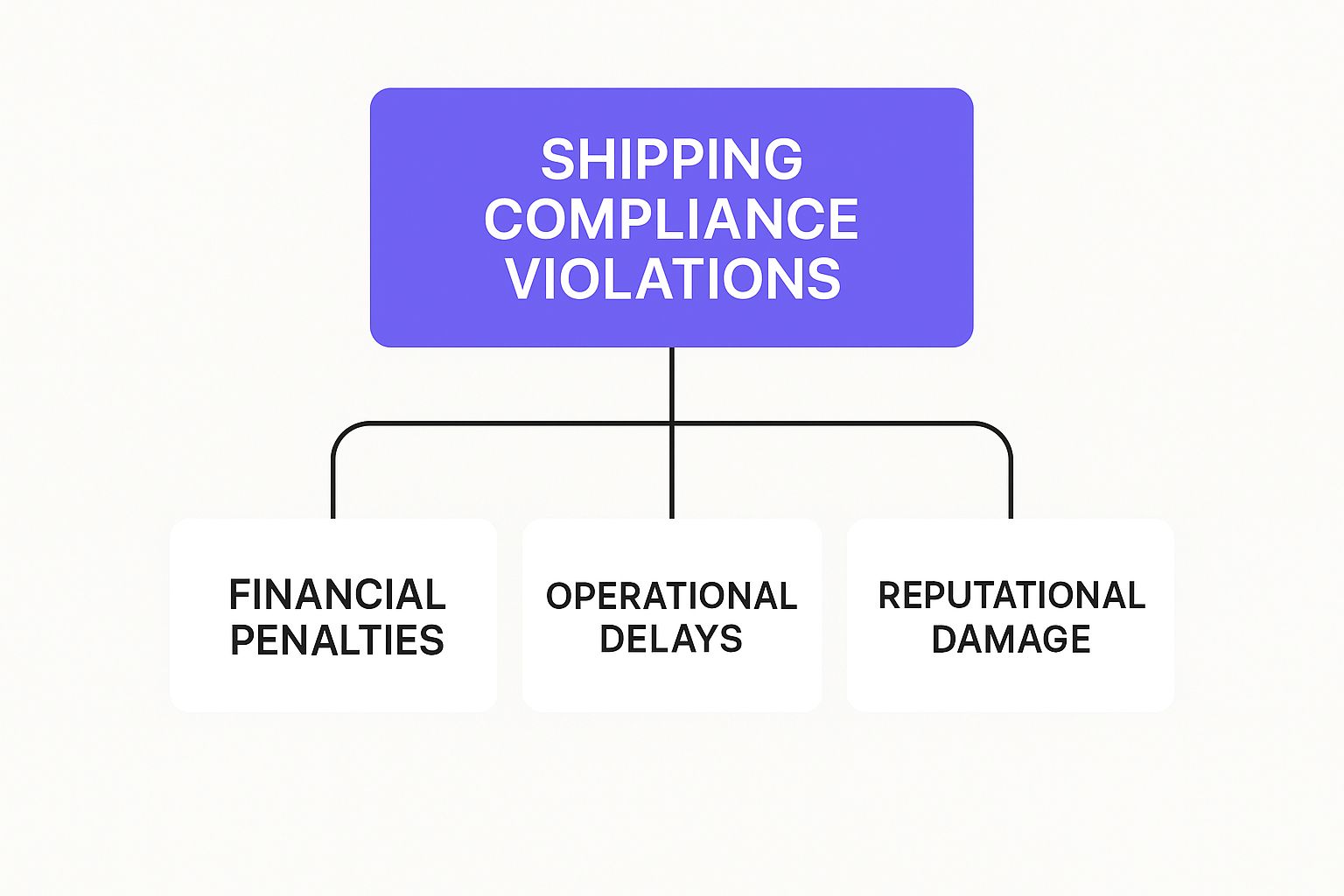
To help visualize this, let's break down the primary cost categories that spring from a single compliance failure.
Overview of Compliance Violation Costs
| Cost Category | Description | Example Impact |
|---|---|---|
| Direct Penalties | Government-issued fines and penalties for the specific violation. | A $10,000 fine from a federal agency for improper documentation. |
| Operational Costs | Expenses incurred from shipment delays, storage, and re-routing. | $5,000+ in unexpected demurrage fees for a container held at port. |
| Legal & Admin Fees | The cost of hiring lawyers and consultants to resolve the issue. | $25,000 in legal retainers to fight the violation and negotiate a settlement. |
| Reputational Damage | Loss of customer trust, negative reviews, and brand erosion. | A 20% drop in new customer acquisition following public news of the violation. |
| Long-Term Impact | Increased insurance premiums and loss of future business opportunities. | An insurance provider classifying the business as "high-risk," doubling annual premiums. |
As you can see, the initial fine is often the smallest part of the problem.
The true cost of a shipping compliance violation is a complex mix of financial, operational, and reputational consequences. Understanding these interconnected risks is the first step toward building a resilient strategy—especially when you realize that just following state-level rules often isn't enough. To dig deeper, check out our guide on why county-level shipping restrictions matter.
Breaking Down the Direct Financial Penalties
When you mess up shipping compliance, the first and most obvious hit is to your wallet. We're talking about direct financial penalties—concrete, often staggering fines from government agencies whose entire job is to enforce trade laws.
Think of these penalties as the first shockwave from a compliance earthquake. It's the first thing you feel, and it's a crystal-clear signal that more trouble is on the way.
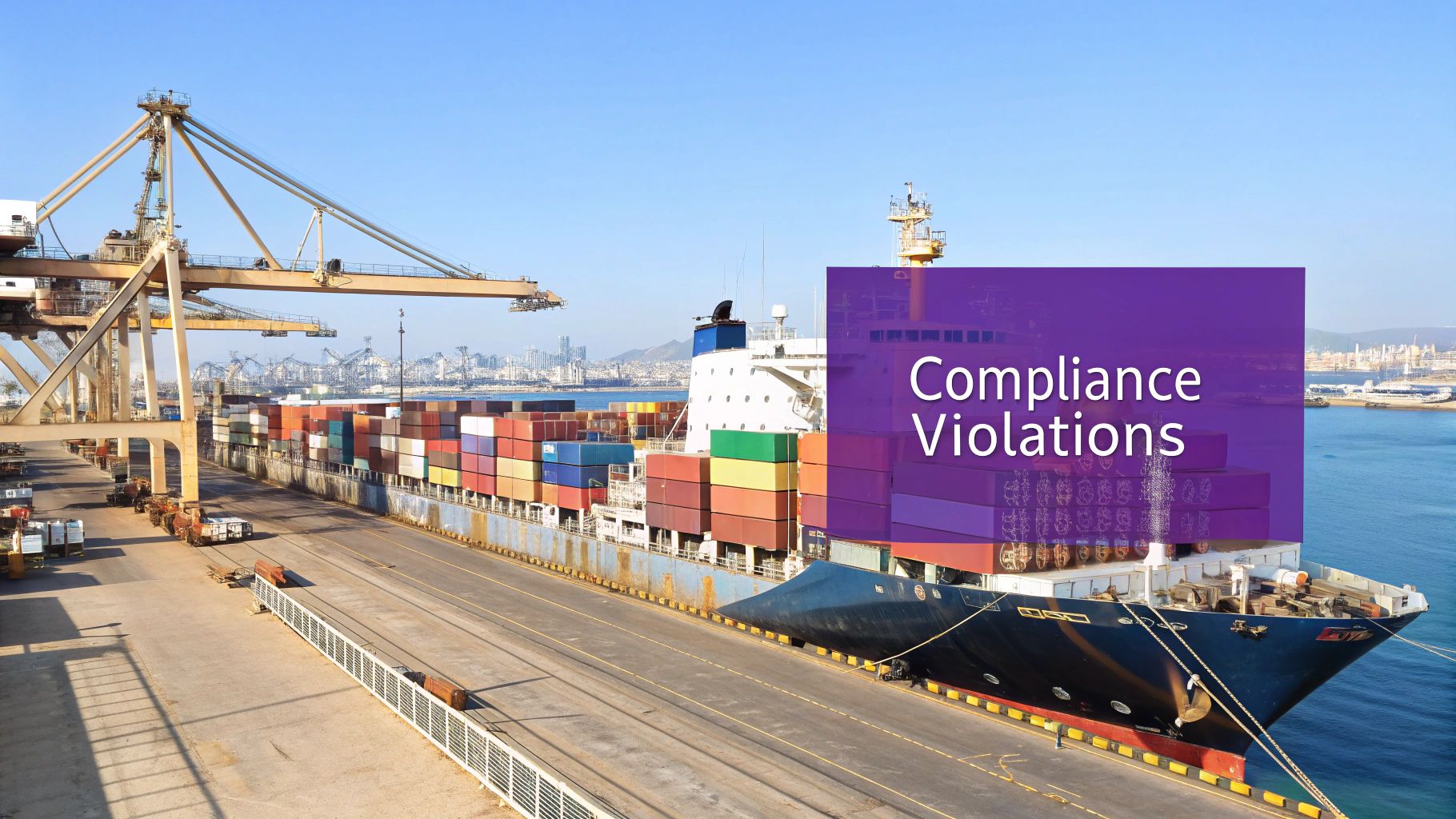
Agencies like Customs and Border Protection (CBP) don't just pull these numbers out of thin air. The final bill is calculated based on the specifics: what was the violation, what were the goods worth, and was it an honest mistake or something more deliberate? A simple clerical error might get you a smaller fine, but intentionally misclassifying products or trying to get around sanctions can lead to a financial catastrophe.
Common Triggers for Hefty Fines
A few common slip-ups can turn a routine shipment into a massive liability. Knowing what they are is the first step to avoiding them.
- Customs Misclassification: Using the wrong Harmonized System (HS) code is a classic mistake. It throws off duty payments, and customs agencies will penalize you heavily for it.
- Improper Valuation: This is a big one. Under-declaring the value of your goods to sneak by with lower tariffs is a serious offense that can trigger fines far larger than any duties you might have saved.
- Sanctions Evasion: Shipping to a prohibited country, company, or individual is the red zone of compliance violations. Even if it's an accident, this carries some of the most severe penalties in global trade.
These aren't just hypotheticals, and they aren't limited to one part of the world. As enforcement gets tougher, companies are facing unprecedented fines. In Europe, one financial firm was slapped with a £29 million (roughly €34.5 million) fine for sanctions-related violations. In Lithuania, authorities hit two companies with fines of €13.61 million and €8.24 million for the same reason. You can dive deeper into these trends in this detailed analysis of 2024 compliance lessons.
From Negligence to Intent: The Fine Multiplier
How bad will the fine be? A lot of it comes down to intent. Regulators draw a sharp line between simple mistakes and calculated attempts to cheat the system, and the penalties reflect that.
A violation from simple negligence might cost you a percentage of the unpaid duties. But if they can prove gross negligence or outright fraud, fines can skyrocket to several times the total value of the goods—potentially hitting millions of dollars for a single shipment.
This tiered system means your company’s compliance track record matters. Your demonstrated efforts to follow the rules (or lack thereof) will play a huge role in the final number. For industries with notoriously tricky rules, like online alcohol sales, knowing these details is absolutely critical. You can learn more about those specific challenges in our article on how state excise taxes affect online alcohol sales and shipping.
These direct financial penalties are a powerful wake-up call, making it clear that the true cost of a compliance violation starts with a major blow to your bottom line.
The Ripple Effect of Supply Chain Chaos
A hefty fine might feel like the first punch, but the real knockout blow from a compliance violation is the supply chain chaos that follows. Think of your logistics network as a busy highway; a single violation is like a multi-car pileup, grinding everything to a halt. The operational fallout often ends up costing far more than the initial penalty ever did.
The first domino to fall is almost always a shipment seizure. When customs officials flag a container for non-compliance, they don't just issue a warning—they pull it out of circulation entirely. Your goods get impounded, locked away in a port warehouse while an investigation unfolds. This can take weeks, sometimes even months.
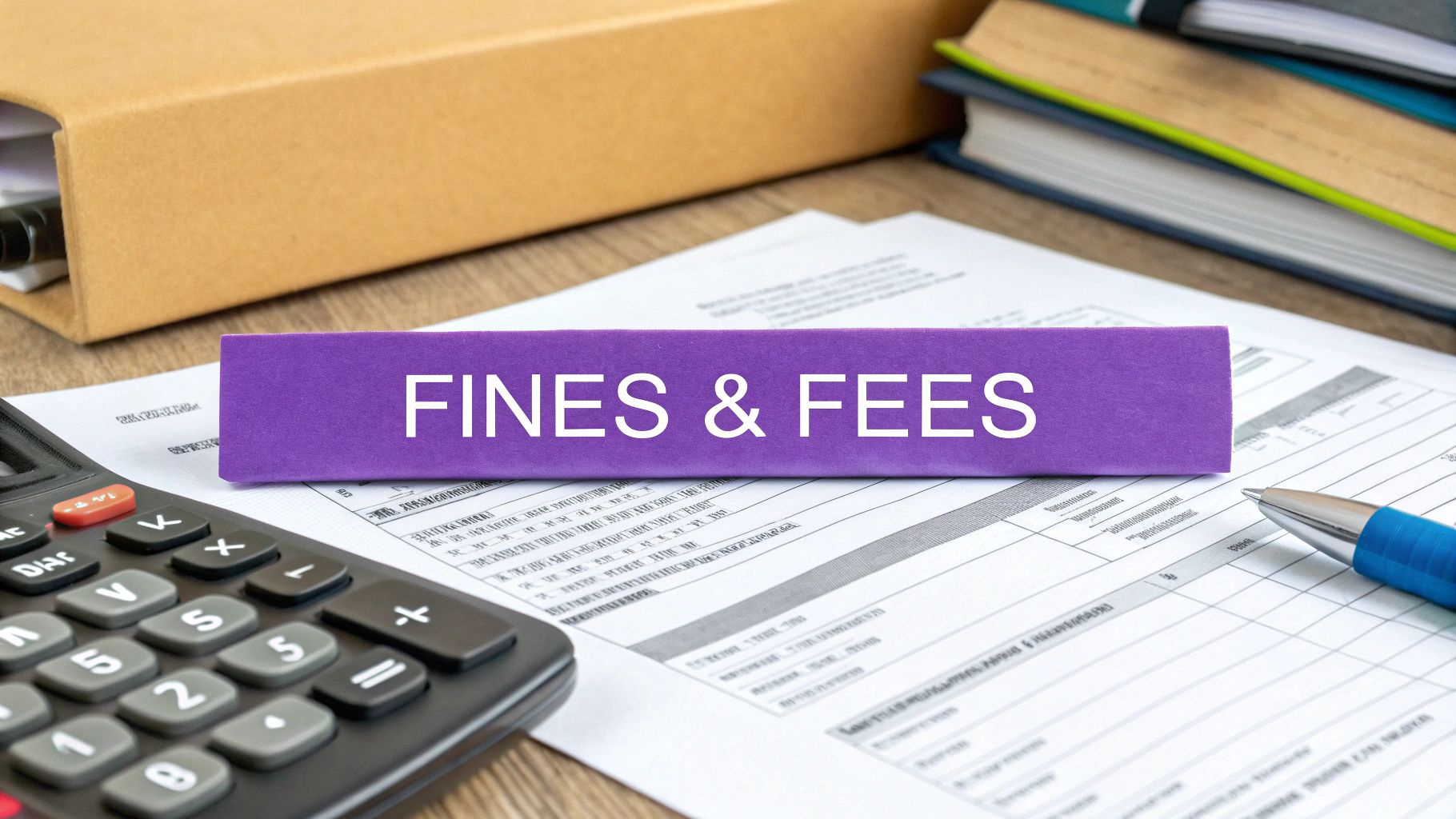
This single event kicks off a cascade of expensive secondary problems. Your entire operation is thrown into disarray as you scramble to manage the disruption, which brings a whole host of unforeseen expenses that add up fast.
The Escalating Costs of Delays
Once your shipment is seized, a new clock starts ticking—one that runs up a whole different set of bills. These operational costs are insidious because they accumulate daily, turning a one-time problem into a relentless financial drain.
Here are the most common charges you’ll face:
- Demurrage Fees: These are penalties the shipping line charges for using their container beyond the allotted free time at the port. With your container stuck in customs limbo, these fees can quickly climb to hundreds of dollars per day.
- Storage Costs: The port or warehouse holding your impounded goods will bill you for every day they sit there. Just like demurrage, these costs compound quickly, creating a massive bill for a shipment you can't even touch.
- Legal and Consulting Expenses: You'll almost certainly need to hire trade attorneys or customs brokers to navigate the maze of getting your goods released. Their expertise is crucial, but it comes at a steep price, often requiring a substantial upfront retainer.
These direct operational costs are just the beginning. The disruption creates a ripple effect that hurts your business in ways that are less obvious but just as damaging.
A single compliance violation effectively puts a red flag on your company's name. As a result, all future shipments are far more likely to face heightened scrutiny, leading to more frequent inspections and further delays.
Long-Term Operational Damage
The consequences don't just disappear once you resolve the violation. That one incident can permanently change how customs agencies see your business, creating lasting friction. A history of non-compliance can easily land you on a "watch list," which guarantees your shipments will be singled out for inspection on a regular basis.
This means you’ll have to start budgeting more time and money for every single import or export. This new reality of constant scrutiny chips away at your competitive advantage, slows down your entire supply chain, and makes it incredibly difficult to keep delivery promises to your customers. The true cost of a shipping violation isn't just a one-time penalty; it's the long-term operational drag it puts on your entire business.
Navigating Customs Enforcement and Import Penalties
When your shipments cross international borders, you’re playing in a whole new league. This is the world of customs enforcement, where agencies like the U.S. Customs and Border Protection (CBP) wield immense authority. Think of them as the gatekeepers of global trade—and they expect every piece of your paperwork to be flawless.
The guiding principle here is reasonable care. It’s a legal standard that basically asks: did you do everything a prudent person would do to ensure your shipment is compliant? If the answer is no, even if it was an honest mistake, you’re opening yourself up to some serious import penalties. The consequences aren’t just fines; a violation can put a permanent black mark on your company’s reputation with regulators.
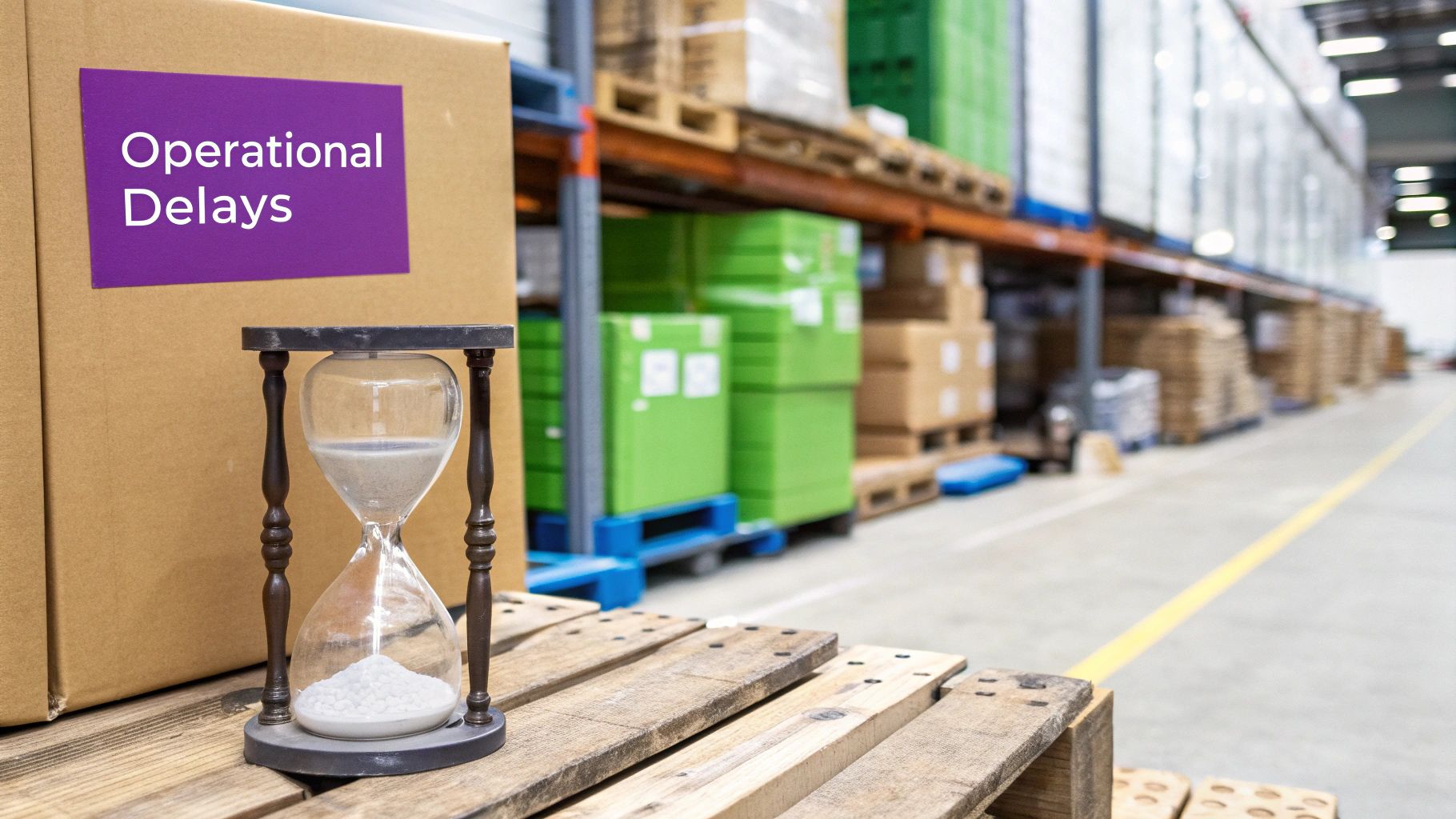
And that scrutiny is only getting more intense. In the U.S. alone, the CBP oversees more than $4 trillion in trade every year. With that kind of volume, they have to be strict. Any slip-up can trigger hefty penalties, cripple your delivery schedule with delays, or in the worst cases, lead to criminal charges. It's no wonder importers are seeing higher brokerage fees and beefing up their in-house compliance teams just to keep pace with the demands.
Common Violations That Trigger Penalties
A few common mistakes consistently land businesses in hot water with customs. These aren't just seen as typos; they're viewed as a failure to exercise that all-important reasonable care, and the consequences are costly.
Here are the big ones:
- Incorrect Tariff Classification: Getting the Harmonized System (HS) code wrong is a massive red flag for auditors. It directly impacts how much duty you pay, and getting it wrong suggests you either don't know your product or you're trying to cheat the system.
- Country of Origin Mislabeling: Falsely declaring where goods were made to get around tariffs or trade restrictions is a huge no-no. Customs officials see this as a direct attempt to deceive them.
- Undervaluation of Goods: This is just plain fraud. Intentionally declaring a lower value for your products to pay less in duties will bring the hammer down, with penalties that can dwarf the duties you tried to avoid.
These aren't minor clerical errors. They are fundamental mistakes that poison the entire import process.
The real danger of a customs violation isn't the one-time fine. It's getting flagged and put on an enforcement "watch list." Once you're on that list, every single one of your future shipments is subject to intense, costly, and time-consuming scrutiny.
That extra attention means more physical inspections, which means more delays. It means higher customs brokerage fees to handle all the extra work. And it means a permanent drag on your supply chain's efficiency. To stay off that list, you need a rock-solid understanding of every single standard, right down to the security seals on your containers. Getting familiar with a detailed guide to container seals and compliance is a great place to start. Mastering these details isn't just a good idea anymore—it’s a matter of survival.
When Violations Turn Criminal: The Human Cost
Corporate fines and operational chaos sting, but some shipping compliance violations cross a line into territory where the consequences get terrifyingly personal. For certain offenses, the true cost isn't paid by the company at all. It's paid by individuals—in the form of prison sentences, personal financial ruin, and shattered careers.
This escalation from a civil penalty to a criminal charge doesn't happen over a simple clerical error on a customs form. It happens when someone makes a deliberate choice to break high-stakes laws related to national security, sanctions, or illegal goods.
The Personal Responsibility Factor
When a violation involves clear intent, regulators and law enforcement stop seeing it as a corporate mistake. They see it as a crime committed by individuals making conscious, illegal decisions. In these scenarios, the corporate veil offers shockingly little protection for logistics managers, compliance officers, or even C-suite executives.
The logic is brutally simple: a company can't make a decision, but a person can. If an individual knowingly falsifies documents to ship restricted technology to a sanctioned country, or conspires to mislabel dangerous goods to sneak them past inspectors, they become personally liable for the crime.
Compliance isn't just a corporate policy; it's a personal responsibility. When an individual knowingly circumvents trade laws, they are gambling with their own freedom and financial future, regardless of who signs their paycheck. This transforms a business risk into a life-altering event.
Real-World Cases and Severe Consequences
These aren't just theoretical risks pulled from a legal textbook. Courts are increasingly willing to hold individuals accountable for corporate misdeeds, especially in export control violations involving sensitive goods.
Recent cases paint a stark picture of the human cost. For example, one individual was recently sentenced to 70 months in prison for smuggling firearms and filing false export declarations. In another case, a defendant was convicted of conspiracy to illegally ship aircraft parts to sanctioned Russian airlines, resulting in 24 months of prison time and the forfeiture of over $2 million. You can dig deeper into these kinds of severe legal outcomes and learn about recent export controls and compliance updates.
These examples are a sobering reminder that the stakes can escalate far beyond a financial penalty for the business. When compliance fails at this level, it's not about losing money—it's about losing years of your life. It drives home the point that for anyone managing global trade, understanding and following the law isn't just good business practice; it's an essential act of self-preservation.
Building Your Proactive Compliance Strategy
<iframe width="100%" style="aspect-ratio: 16 / 9;" src="https://www.youtube.com/embed/tnL-mKe8b_Q" frameborder="0" allow="autoplay; encrypted-media" allowfullscreen></iframe>After walking through the absolute minefield of non-compliance consequences, one thing should be crystal clear: reacting to problems after they happen is a losing game. It’s a recipe for disaster. The only way to shield your business from catastrophic losses is to build a proactive compliance strategy from the ground up.
Think of it less as a business expense and more like an essential insurance policy—one that protects your company’s stability, reputation, and future. A solid program flips the script from cleanup to prevention. It’s about creating systems that flag potential issues long before they ever get near a customs agent. This foundational work is what separates thriving businesses from those constantly putting out fires.
Investing in People and Processes
Your employees are your first line of defense, but they’re only as good as the knowledge and tools you give them. A truly proactive strategy starts by empowering your team with ongoing education and methodical internal checks.
- Continuous Employee Training: Regulations are always in flux. Setting up regular training ensures your team is always current on the latest rules for customs classification, documentation, and restricted party screening. This is your best defense against simple human error.
- Regular Internal Audits: Don’t wait for a regulator to find your mistakes for you. Conducting scheduled internal audits lets you identify and fix compliance gaps on your own terms—without the looming threat of fines or seized shipments.
Putting these processes in place builds a culture of accountability where compliance becomes everyone's responsibility, not just a department down the hall.
A proactive compliance strategy is the ultimate investment in business resilience. It transforms compliance from a burdensome cost center into a strategic asset that protects revenue, enhances reputation, and enables sustainable growth.
Leveraging Technology and Expertise
In today's complex global trade environment, checking things by hand just doesn't cut it anymore. It's too slow and far too risky. Using modern technology and outside expertise is non-negotiable for building a compliance framework that can actually scale with your business. For instance, merchants can find powerful tools for automated shipping compliance for Woo Commerce stores that take a huge amount of the manual effort—and risk—off the table.
This approach really comes down to two key pillars. First, invest in compliance software that automates the critical checks, like verifying shipping addresses against restriction lists or validating product classifications. Automation slashes the error rate and frees up your team to focus on bigger-picture tasks.
Second, build strong partnerships with experienced customs brokers and trade attorneys. These experts offer invaluable guidance on navigating tricky regulatory landscapes and can provide crucial support if a problem does pop up. At the end of the day, viewing compliance as a strategic investment rather than a cost you react to is the real key to long-term success.
Answering Your Questions About Shipping Compliance
When you're wading through the complexities of global trade, a few key questions always seem to pop up. Let's tackle some of the most common ones about the real cost of shipping compliance violations and how to stay on the right side of the law.
What Is the Single Most Common Compliance Mistake?
By far, the most frequent tripwire is inaccurate or incomplete documentation. This isn't just one thing; it's a whole category of potential errors, from using the wrong tariff classifications (HS codes) and undervaluing goods to misstating the country of origin or simply failing to get the right permits.
Even a mistake that seems minor or was completely unintentional can trigger expensive audits, fines, and painful delays. Customs authorities have to rely on the data you provide to assess duties and keep borders secure, making your paperwork the number one risk area, hands down.
Can Small Businesses Really Face the Same Fines as Big Corporations?
Yes, absolutely. While penalties are often scaled based on things like company size, past compliance history, and how severe the violation was, regulatory bodies do not give small businesses a free pass.
A fine that a large corporation might absorb as a manageable business expense could be financially crippling for a small or medium-sized company. This reality makes proactive compliance even more critical when you're a smaller player in the global market.
Technology is a powerful ally in this fight. Modern trade compliance software automates the most tedious and error-prone tasks—like screening against sanctioned party lists, verifying tariff codes, and generating accurate documents—which cuts down on the human error that leads to costly violations.
How Can Technology Help Prevent Shipping Violations?
Think of technology as a critical safety net. Automated compliance systems slash the amount of manual data entry required and provide real-time updates on regulations, which is a massive help in preventing simple human error. As your shipping operations get more sophisticated, making sure your fleet's insurance keeps pace is a crucial part of any forward-thinking strategy. You can dive deeper by understanding the impact of technology on trucking insurance and seeing how it fits into a modern compliance framework.
Ultimately, these tools are essential safeguards that protect both your shipments and your bottom line.
Don't let shipping compliance mistakes put your business at risk. Ship Restrict automates complex shipping rules directly within your WooCommerce store, ensuring every order is compliant before it ever leaves the warehouse. Learn how Ship Restrict can protect your business and save you from costly violations.

Cody Yurk
Founder and Lead Developer of ShipRestrict, helping e-commerce businesses navigate complex shipping regulations for regulated products. Ecommerce store owner turned developer.